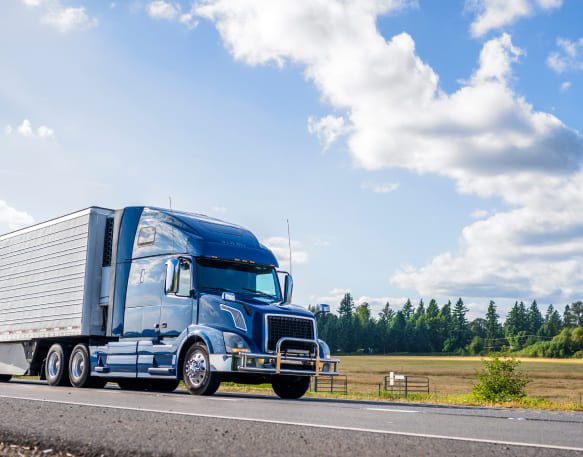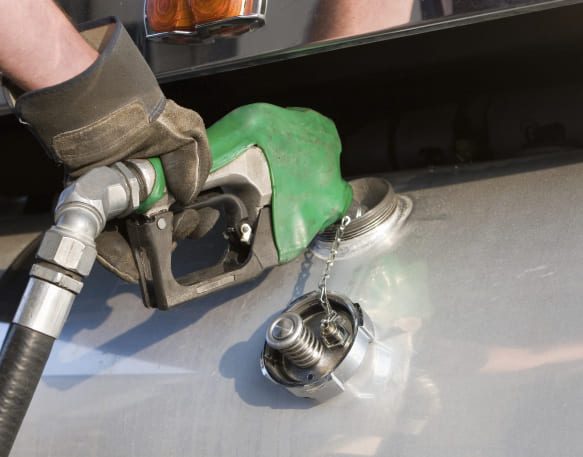From hot shot trucking to local deliveries to cross-country trips, truckers have many options when it comes to which loads they pick up and where they go. With 2 million of the 3.5 million active truck drivers in the U.S. in 2019 working as over the road (OTR) truckers, OTR trucking is an incredibly popular option.
OTR drivers are responsible for moving 71% of the freight in the U.S., putting them at the heart of our economy. Without OTR transportation, manufacturers and stores would need to turn to a combination of trains and local or regional trucking to receive new inventory — but who exactly are these drivers, and what do they do?
This article will go over the meaning of OTR, what OTR drivers do, how to become an OTR driver, challenges in over the road truck driving jobs, how drivers can find OTR loads, and more.
What Does OTR Mean in Trucking?
So, what exactly is over the road trucking? It’s a form of trucking that involves transporting freight over hundreds or even thousands of miles, often crossing state lines and national borders. While most short-haul truckers drive up to 250 miles and are typically home by the evening, OTR truckers can drive thousands of miles and spend days, weeks, or even months at a time on the road.
An over the road truck driver might haul vehicles, consumer goods, heavy machinery, construction, manufacturing materials, or food. Some even transport hazardous materials or dry bulk goods in tankers. Essentially, an over the road driver can handle anything that needs to be transported by land.
Given how long trips can take and how lonely it can get on the road, some OTR drivers pair off to form teams. Not only can having a partner keep the loneliness at bay, but it’s also a very practical decision. Since the drivers will be able to operate in shifts, they can comply with driving regulations without sacrificing time on the road.
OTR Trucking in Context: The First-Mile, Middle-Mile, and Last-Mile
While the focus of this piece is on OTR trucking itself, understanding OTR means understanding its context. OTR trucking is just one portion of the larger logistics industry. In fact, logistics are broken into three key segments: first-mile, middle-mile, and last-mile logistics. Let’s take a closer look at each of these segments:
First-mile logistics: This is the first stage of the logistics process where goods are transferred from the manufacturer to the distribution center or warehouse. Products can originate from anywhere in the world. No matter where they begin, wherever the products go next is considered the first mile.
Middle-mile logistics: OTR trucking is part of the middle mile, or the stage where goods are transferred from warehouses and distribution centers to fulfillment or storage facilities. While the length of time of the middle mile can vary greatly depending on the origin and destination of the shipment, the importance of this section is always the same.
Last-mile logistics: The final stage of the logistics process is the last mile, where goods are transferred from fulfillment facilities, like retail stores or transportation hubs, to the final delivery destination, typically a consumer’s hands. The goal of this stage is speed, as anyone who’s ever ordered a product with same or next-day delivery knows all too well.
How Much Do OTR Truck Drivers Make?
Over the road trucking companies are always looking for new drivers — especially in today’s trucking shortage — and they pay accordingly. Compared to other trucking jobs, OTR driver jobs typically offer a higher salary, though the exact amount can vary depending on years of experience, routes, types of loads, and more.
The average salary for an OTR truck driver is $56,418 per year, and the median is $56,000, according to PayScale. However, some OTR drivers make as little as $38,000 per year, while others make $79,000 or more per year. Typically, those with more experience and certain endorsements make salaries towards the top of the range.
What Is the Difference Between OTR vs. Regional vs. Dedicated?
It’s important to note that, although OTR, regional, and dedicated truck drivers can all haul similar types of loads, they aren’t the same.
As mentioned, OTR truck drivers haul freight over long distances and, as a result, spend a lot of time on the road. However, local truck drivers, or short-haul truck drivers, typically deliver loads within a 200-250 square mile radius. Sometimes this can mean crossing state lines, and it often requires traveling on smaller, local roads instead of the highway or driving a smaller truck and making multiple stops along your route to drop off goods. Many local truck driver companies require their drivers to have a year or more of CDL driving experience due to the challenges of navigating smaller roads and backing into tight loading docks several times each day. Drivers are generally home within 8-10 hours, making it an excellent option for those with families. However, it pays less than regional and OTR trucking.
Regional truck drivers fall somewhere in between local and OTR truck drivers. A regional truck driver will only operate in a specific part of the country and typically within a 1,000-mile radius. For example, a regional driver might only pick up and deliver loads in the Northeast or the Midwest.
Compared to OTR trucking, regional driving pays less. However, the tradeoff is worth it for many drivers, as they can spend more time at home with their families while making more money than they would as a local truck driver. Plus, time off for many regional routes coincides with the weekends.
There are also dedicated truck drivers who regularly deliver for the same company or follow the same route. As a result, a dedicated truck driver will become quite familiar with their routes, their schedules, and the people who work at the pickup and drop-off locations.
How to Become an OTR Truck Driver
The first step to becoming an OTR truck driver is earning your commercial driver’s license, or CDL. Without one, you won’t be able to legally operate large and heavy vehicles in commerce.
Each state has slightly different licensing processes, but you’ll need to pass a written test and a practical driving test regardless of your location. To prepare, consult and study your state’s CDL handbook. If you need more structure to learn effectively, you can also attend a trucking school and take a CDL course.
However, all CDLs are not created equal. There are actually three different classes of CDLs, including:
- Class A CDLs: The Class A CDL is the most common type of CDL. You’ll need a Class A CDL if you want to drive a truck with a gross combination weight rating (GCWR) of 26,001 pounds or more if the towed vehicle is heavier than 10,000 pounds. Once you have your Class A CDL, you can operate flatbeds, tractor-trailers, tractor-trailer buses, tanker vehicles, semi-trucks with flatbed trailers, and livestock carriers. With a Class A CDL, you’ll also be able to operate most Class B and C vehicles.
- Class B CDLs: A Class B CDL is required to drive a vehicle that isn’t hitched to a trailer and has a combined weight greater than 26,001 pounds or more. Once you have your Class B CDL, you can operate straight trucks, box trucks, tractor-trailers, dump trucks with small trailers, and a variety of passenger buses. However, if you’re planning to tow something, the trailer must have a gross vehicle rating below 10,000 pounds.
- Class C CDLs: If you plan to operate a single vehicle with a GCWR of fewer than 26,001 lbs, tow another vehicle that weighs less than 10,000 pounds, or transport hazardous material, you’ll need a Class C CDL. With your Class C CDL, you can operate passenger vans, small trucks while towing a trailer, and small trucks with HAZMAT (if you have the proper endorsement.)
You’ll need to pass a CDL HAZMAT written knowledge test to transport hazardous materials to gain your H endorsement. Other CDL endorsements include:
- The N Endorsement: This will enable you to drive a tanker vehicle and transport liquids and gasses.
- The T Endorsement: This endorsement will allow you to drive a double or triple trailer.
- The X Endorsement: The X Endorsement will permit you to operate a vehicle with hazardous materials in a tank.
The Challenges of Being an OTR Trucker
Once you’ve earned all the necessary licenses, it’s time to become an OTR driver! However, life as an OTR trucker isn’t easy. Not only will you need to sacrifice spending time at home to spend several days driving across the country, but you’ll likely face terrible weather, traffic jams, and limited food options out on the road. Other challenges of OTR trucking include:
- Hours of Service (HOS) Rules: HOS rules were initially introduced in the 1930s, though they’ve changed a little over the years. According to current HOS rules, you can’t drive over 11 hours after 10 consecutive hours off duty and can’t drive beyond the 14th consecutive hour after coming on duty. You must also take a 30-minute driving break after 8 cumulative hours of driving and can’t drive for over 60 hours in 7 consecutive days or 70 hours in 8 consecutive days. If you hit these limits, you will need to wait for your hours to drop off or spend 34 hours off duty. To more strictly enforce HOS rules, the U.S. federal government enacted an electronic logging device (ELD) mandate in December of 2019. All carriers and drivers must use ELDs to record their driving hours.
- Lengthy Detentions: As an OTR truck driver, you’ll also often experience delays when picking up or delivering loads. These detentions typically take two to two-and-a-half hours but can occasionally last longer and throw a wrench in your schedule.
- Poor Infrastructure: Unfortunately, much of the U.S.’ infrastructure is aging and in poor condition, which can make driving across the country difficult. 65% of major U.S. roads are in ‘less than good condition,’ according to the U.S. Department of Transportation. It’s also worth noting that 42% of bridges in the U.S. are 50 years old — or older! — and 46,154 bridges are currently structurally deficient.
- High levels of stress: Spending so much time on the road and away from your family can be stressful as you figure out how to balance your personal life with such a time-consuming job. On top of that, you’ll need to deal with poor weather and visibility, construction, traffic jams, tight deadlines, and more.
- Physical health issues: Plus, OTR trucking is stressful on the body. Not only will you spend days — or even weeks — on the road at a time, but you’ll also likely spend that time sleeping in your truck’s cabin or motels and picking up fast food from rest stops. While being an OTR trucker involves a lot of travel, it’s a very sedentary job and, as a result, can result in health complications. Compared to the national working population, long-haul truckers are more likely to report having diabetes and are more than twice as likely to be obese (69% vs. 31%) or have morbid obesity (17% vs. 7%).
Find Success as an OTR Trucker With DAT’s Help
While having a good OTR load board won’t solve all of your problems, it can help you locate OTR truck driving jobs headed to destinations you’d like to end up in, save you time, and help you find high-paying OTR loads to maximize your profits.
DAT’s load boards are easy to use and navigate, so you can quickly find and secure the loads you want. Plus, you won’t have to constantly refresh your page for fear of missing out on top-paying OTR trucking jobs. Just set your customized alarms and wait for a notification from us. You can even access our load boards while you’re on the go with our mobile app.
Not only is our load board updated in real time, but it’s also the largest load board in the industry. Nearly 644,500 loads are posted to the DAT load board each day, so you can easily find a load that suits your needs, regardless of your vehicle or trailer type. And over 216,500 daily loads are exclusively posted to DAT, giving you the edge over the competition.
At DAT, we know that every business is different, so we offer several subscription plans. With our standard plan, you’ll be able to post your truck and comb through DAT’s load boards to find the perfect loads. However, if you need more tools, you might be better off with our enhanced or professional plans. When you upgrade, you’ll receive features like intelligent triangle routing suggestions to maximize your time on the road and average lane rates based on real transactions to improve your negotiations.
So, whether you’re just starting as an OTR driver or already managing a large OTR fleet, DAT has you covered.
Find OTR freight with DAT!
You can’t be a successful OTR trucker without quality freight! Enter the DAT load board.
Not only can you filter through loads with the DAT load board, but you can also view crucial information like average lane rates and broker reviews. Start finding freight with the DAT load board today!




